Sculptures
After my studies in Florence Italy~1990. I asked my professor in painting if he would mark my sculptures rather then my painting for his class. He said, “yes” and I made my way to the foundry area. With Barbara Fletcher, believing in me and her help behind the scenes to keep me in the studio this is what I produced. Thank you Barbara.
“Emotion”
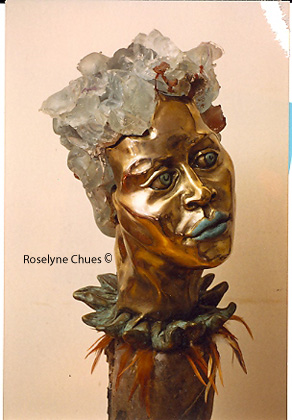
- Emotion~Bronze and Glass~ Life size
The other sided of the solid Bronze emotion is the translucent Glass.” “Intellect”
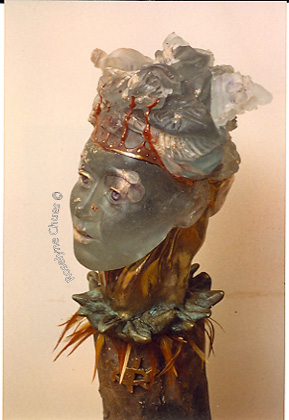
- Intellect ~ Glass and Bronze~ Life Size
There is a little story on the top ~ can you see it?
“Link”
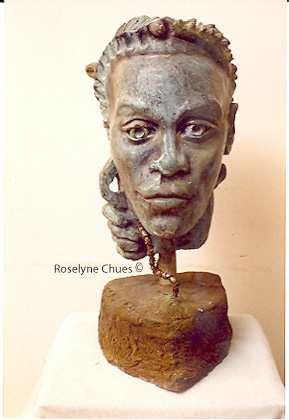
- Sculpture ~ Life Size
Paradox Series~ I See The Bee,Do U C the B?
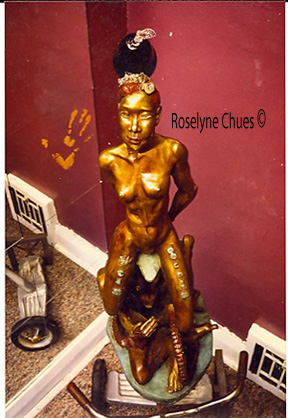
Bronze and Ready Made ~ 2’x4′Paradox/Pair O’Docs/Pear A Docks
A Canadian Art Council Grant recipient in 1995, Paradox/Pair a doc/Pear of dock~ An oil on canvas painting called “First Book” that is sold in 1996, measuring 3’x4’.
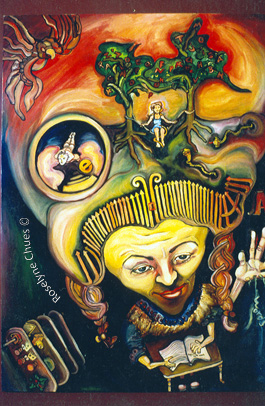
- First Book ~ Prints are Available
“Paradox/Pair O’Docs/Pear A Docs” Exhibition 1995
ARTI ST STATEMENT Roselyne Chues
Thank you for help in the write: to Cynthia Richardson
INTRODUCTION
1.
Before I intrigue you with the proposal of my abilities, I would first like to start by telling you a little about myself. I was born in the city in 1969. Yet I found myself enchanted by the beauty of nature. The power in nature helps me to cope with my disability for I am a dyslexic person. For some, dyslexia spells fear. For some, sorrow and for others pain. Dyslexia is a threshold between success and failure. Yet, to people like myself who sometimes can’t even read the word “dyslexia”, it spells beauty and inspiration.
Proposal writing is exactly one of the processes which I find a hugh obstacle, as it is not my language. It is ironic that a person who is so visual has to verbalize before they can communicate.
PROPOSAL
2 .
The proposed body of work will focus on issues around different learning abilities and my own experience with dyslexia. There are a number of reasons why I would like to do this presentation; some of these are artistic, some exploratory and educational for the public and my own growth as an artist.
One of the reasons for doing this work is to describe the frustration of not having access to the written word and not being able to explain what I would like to express to other people. When I write the written word, it does not convey my vision. Like mud or quicksand, I can’t seem to do anything about it. I feel immobilized and the more I struggle, the more difficult it is for me to find the right words. It is in my head and I can’t get it out. At times, my whole body mirrors this lack of confidence in relation to the confined verbal space. To me, verbal space means the language of society; where my language exists as a visual context. For me, written and verbal communication often leads to misunderstanding but my art seems to speak directly to the hearts of people. Showing my paintings is showing my language to another person.
With these sculptures and paintings, I want to convey what my form and degree of dyslexia feels like. The degree of difficulty changes and fluctuates from moment to moment. I am constantly struggling to find other mediums of thought through ideas and words to articulate what I have to say. And within my artwork, I will convey this by using different materials to show the different degrees of compensation. I am skilled with this adaptation process, my art speaks to people on a number of levels.
Visually when I see words, like the letter “C”, it is a form; a nice curve; and I don’t see it as a symbol describing the sound it should make. It is a symbol to communicate something but for me that “C” sometimes doesn’t exist; dyslexia is letter blindness.
The past allows me to remember words. For example, the word “the” is remembered by the experience of the letter “t” being associated with the word “tree”. Because in primary school, the letter “t” was presented with a picture of a tree beside it. Therefore, I see the word “THE” as a “TREE” vision, with the “t” and “h” as the tree/branch and the “e” as a leaf. Sometimes I only see parts of words, for example; I see the word “TENT” in the word “CONTENT”. So in a sentence, I will get confused because I will only see parts of the word.
MATERIALS
3.
This body of work will be figurative and involving the audience welcoming them into an experience of how it feels to be dyslexic. Using different materials and found objects to create paintings and sculptures, I will use these symbols to convey a story of my own mind and how it adapts to ideas, to verbal media, to my environment and my psychological processes of the moment.
As part of the body of work, I will use written text to explore its use as a form, as I do in my day to day life. Some of this written text will be drawn from the research. I will also address the notion that within our society dyslexia is often an unknown and unacknowledged condition. The experience of dyslexia is hidden away and often denied. By using lead, which has the potential to be dangerous in an unseen way, my work will convey the untouchability and perceived danger of the dyslexia phenomenon. By adapting and handling both lead and dyslexia in a very particular way, they both render an extraordinary result.
I will use bronze because it is a majestic material and I want to give light on “dyslexia”, and attract attention where people try to hide it. People with dyslexia do not reveal it so easily, therefore, society doesn’t acknowledge it. I would like them to look at it and not see it as being ignorance but just a different way of processing information. It is a totally different way of learning, which in itself should be appreciated